
Created: 15 August 2002
Updated: 30 June 2016
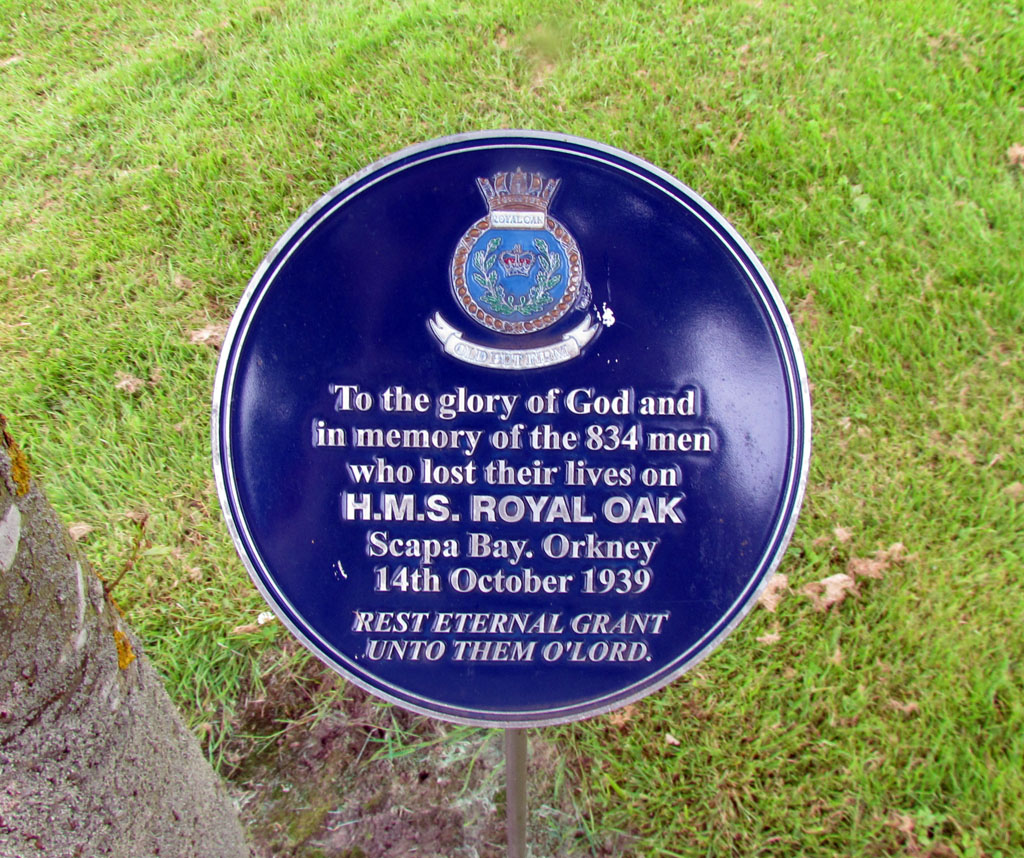 |
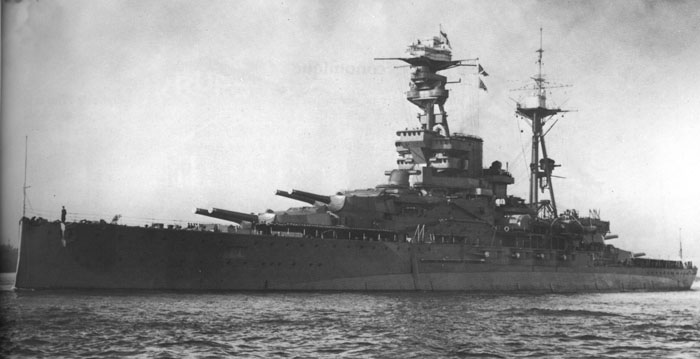 |
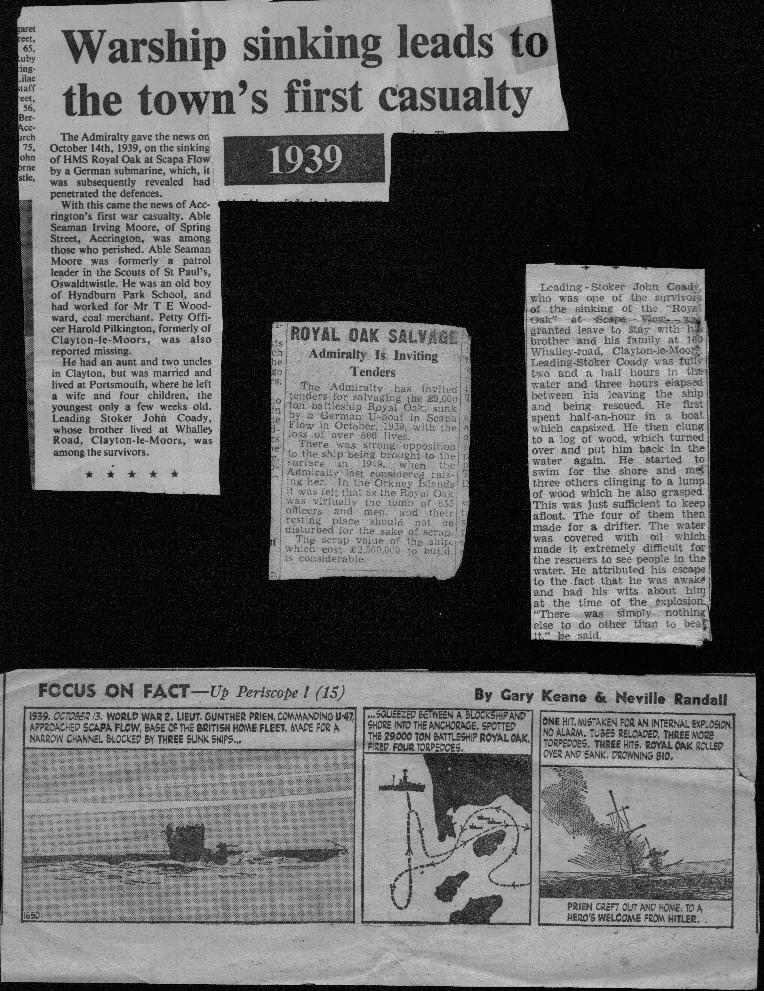 |
|
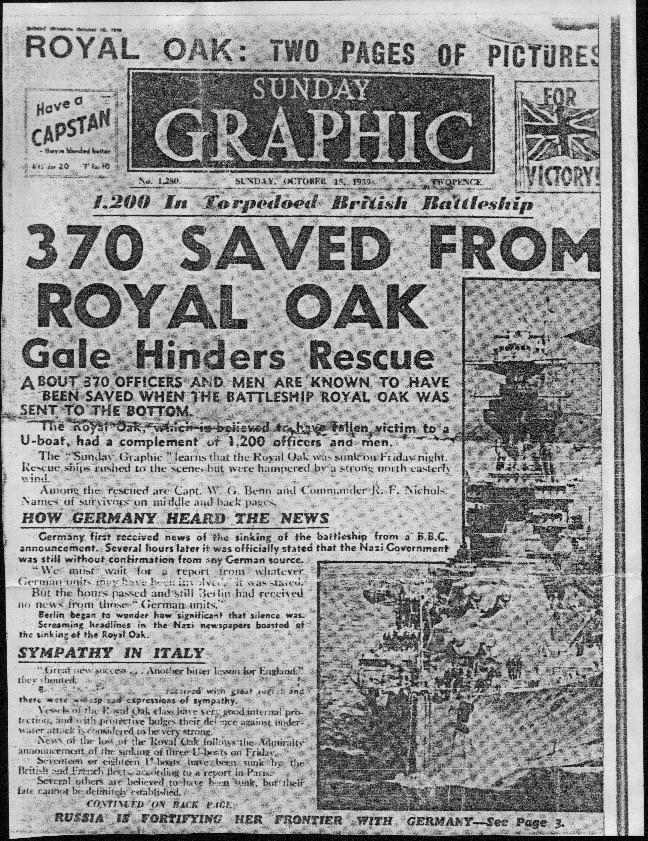 |
|
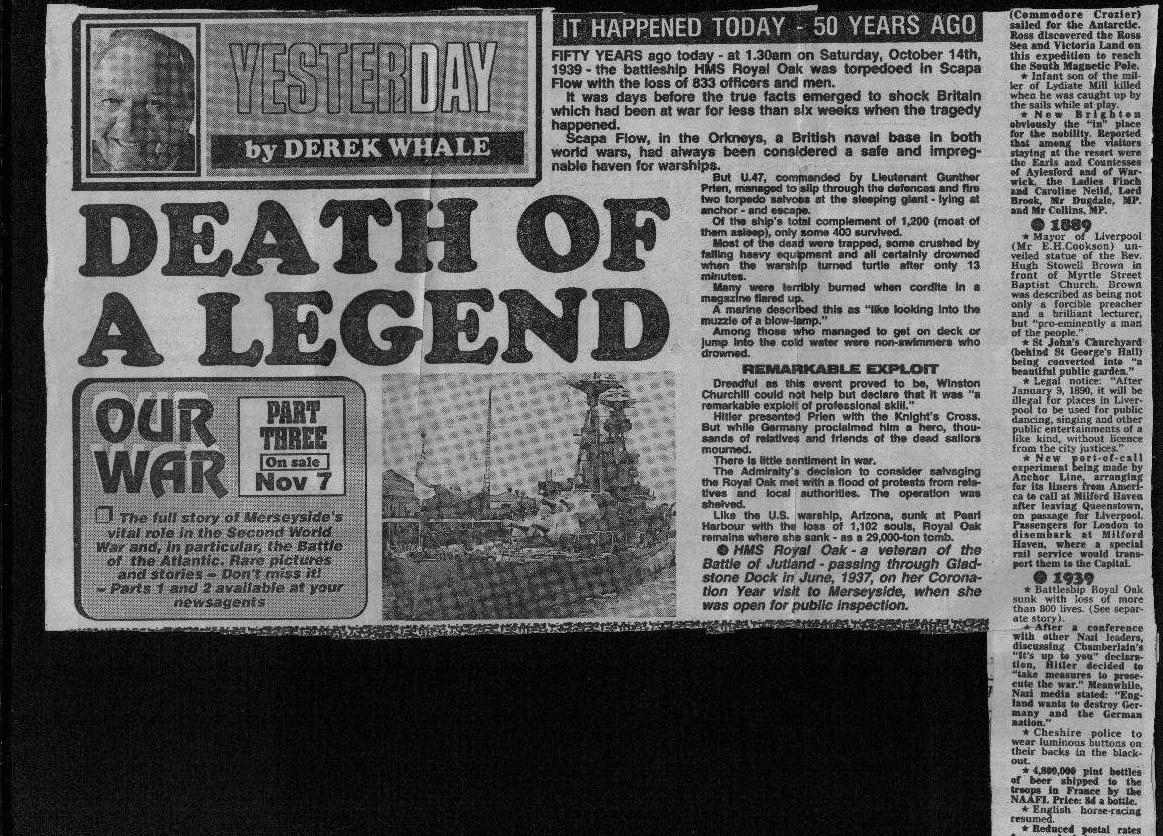 The above images were sent to me by "Pauline" from a Scouser's Forum |
|
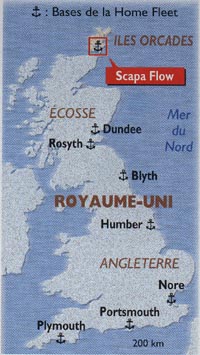 |
At 0116hrs on 14
October 1939 the British Battleship Royal Oak was torpedoed whilst in the
"protected" anchorage at Scapa Flow. She took 15 minutes to sink the
13 fathoms to the bottom, drowning 833 crew. The U Boat responsible was
U-47,
commanded by Günter Prien. The above are newspaper articles past and more recent
detailing this event. The third image gives the details as for a local sailor
who became Accrington's first war casualty, Able Seaman Irving Moore. Another
Accrington lad, Leading Stoker John Coady was a survivor. 833 died that day. The
first the German's knew about it was an announcement on the BBC! The first
image above is the front page of the Sunday Graphic dated October 15th 1939. The
first torpedo that hit was treated as an "internal explosion" and Prien had time
to reload his tubes and fire again. Most of the dead were drowned when the
ship turned over after 13 minutes. Many were burnt when powder magazines
went up. Non swimmers who made it over the side also drowned. Despite the
tragedy, Winston Churchill described it as a "remarkable exploit of professional
skill". Like the Arizona at Pearl Harbour, the Royal Oak remains to this day, a
29,000 ton tomb. The image of the Royal Oak on image 2 shows her passing through
Gladstone Dock in Liverpool, the same dock as that used by
Captain Walker and
his 2nd Support Group, the famous "U Boat Killers". |
| From John Lienhard. University of Houston, USA. The University of Houston's College of Engineering presents this series about the machines that make our civilization run, and the people whose ingenuity created them. Scapa Flow is a sheltered bay nestled in the Orkney Islands just beyond the northernmost tip of Scotland. The Orkneys are flat, green, and quite beautiful. A buoy with a memorial plaque bobs in Scapa Flow. Eight hundred sailors from the English battleship Royal Oak are entombed below it. I was in fourth grade when a German U-boat made its daring raid into the very middle of this sheltered anchorage and found the Royal Oak there on Friday the 13th -- in October, 1939. One torpedo from the first salvo hit the ship, and it did minimal damage. It wasn't clear to the crew what the muffled WHUMP! really meant. (Most though an internal explosion) The Germans were given the twenty minutes they needed to reload a second salvo. This time they scored three solid hits. In minutes the ship had capsized and sunk. It landed with its superstructure crushed on the bottom and the keel just thirty feet from the surface. Only a third of its crew -- chilled and oil-soaked -- got out alive. |  Gunther Prien |
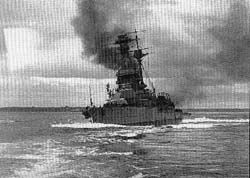 |
It was frightening news for me. The gathering clouds of WW-II had darkened my childhood ever since the Japanese and Italians invaded China and Africa. Now the pride of the British Fleet had been sunk in home waters. In my childish fear, I asked how long it would be before I saw enemy submarines in the Mississippi. The Royal Oak was state-of-the-art naval weaponry when it was built in 1914. Its great 15-inch guns were then the largest ever put on a ship. By 1939 it bulged with protective siding to absorb torpedo impacts. But technology had moved too quickly, and that siding wasn't enough to absorb the new German torpedoes. The Royal Oak was, ironically, not the first battleship that went to the bottom in that cold, quiet anchorage. Twenty-nine years earlier, after WW-I, the Allies had herded the defeated German Navy into Scapa Flow. Then, without warning, German skeleton crews made a kamikaze decision. They scuttled their whole fleet before the Allies could react.
|
| So there's far more than just the Royal Oak at the bottom of Scapa Flow. The surface of those waters is still smoothed today by slow, unremitting oil leaks that's gone on for 70 years. (Now being removed by MOD Contractors) The well-built hull of the Royal Oak still holds air pockets that its drowning sailors never reached. Of course, we saw no German submarines in the Mississippi River. Eight hundred English sailors were a tiny fraction of the millions who died to prevent that. And Scapa Flow is a mute monument to the head-over-heels arms races that fueled those two failed wars of conquest. It is as beautiful a cemetery for yesterday's war machines as it is for the men who died in them. I'm John Lienhard, at the University of Houston, where we're interested in the way inventive minds work. |
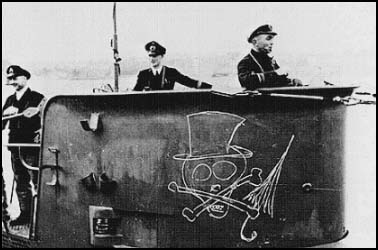 U47 At Kiel |
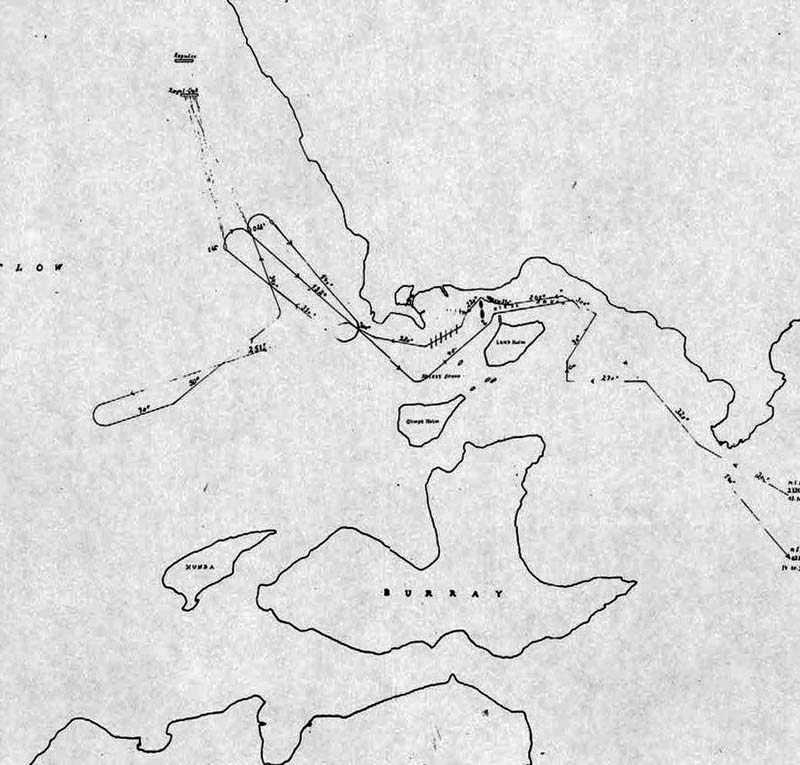 Course of the U47 |
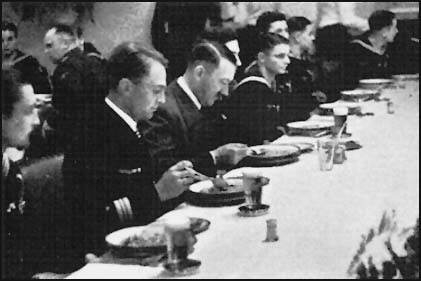 Prien sits next to Hitler |
|
A Survivors Story When the torpedoes struck, most of the men were asleep. Joe Instance was on the main deck, just beneath the forecastle: "I was off watch, in my hammock, when suddenly there was an enormous explosion. It shook the ship from end to end. I said "Come on lads, now get out of your hammocks and we'll find out what's going on". They all just sort of leaned over and said "No, don't worry about it", and not one of them got out. I thought I'm the Leading Hand on this mess and I think I should try and find out what is going on. I got dressed and went aft to the officers, they should know what's going on. When I got aft, there was a small head (toilet) and I needed to go. There was a chap next to me when the next three torpedoes hit. The last torpedo set off the cordite magazine. We were just going out when this hot orange blast came up through the decks, knocking me right back into the toilet. All I could do was hide in a corner, covering my face and hope for the best. The chap who was next to me, all he had on was a vest and a pair of pants and when this flame struck he went up like a torch. MY clothing saved me and it saved my body. I was burnt on the hands, face, back of my neck and all my hair was gone. I must have fallen unconscious for about 5 minutes. I knew I had to get out. Even in the dark I knew where to crawl. It wasn't until I got to the door of the quarterdeck I realised I wasn't crawling along the deck but the bulkhead - the ship was over about 60 degrees. I went straight out of the door, sliding down the deck and got caught by the guardrails. A young midshipman, still holding a telescope, asked me if "we should abandon ship Sir" I don't know who he thought I was. Before I could answer we were off and floating into the dark. I was finally, painfully, hauled onto a raft by someone. Leading Seaman Joe Instance was the only survivor from his Mess. "We were all bandaged up, just a couple of holes for eyes and mouth". He had been on the danger list for about 2 weeks. My wife came to see me and walked right past, I had to shout to her "I'm Joe!" Yet, within a year, Joe was back at sea, this time on a destroyer. "On that and every ship I served on, I would walk around with eyes shut tight, learning my way about, as if in the dark. If it happened again, I wanted to know my way around exactly. From U Boat.net (all hyperlinks in this article lead to uboat.net cross references) |
The German Viewpoint On the peaceful Sunday afternoon of October 1, 1939–exactly a month into World War Two–a small launch motored across the harbor at Kiel, Germany, to tie up beside the depot ship Weichsel. Kapitänleutnant Günther Prien of the German Kriegsmarine disembarked, and was presently met by a runner. "Will Captain Prien please go to the C.O?" The "C.O." was Commodore Karl Dönitz, Commander of U-Boats. Prien was about to begin "Special Operation P," one of the most audacious missions of the World War II. Winston Churchill would call it "a remarkable exploit of professional skill and daring." The Commodore was an old submarine hand from the First World War, when Unterseeboots had very nearly starved England to death. He believed a force of 300 subs would finish the job this time around. But stealthy U-boats didn’t conform to Hitler’s vision of noble German naval might, so Döenitz began the war with just 56 boats, only about half of which were the open-water Types VII and IX. He’d planned to deploy them in "wolfpacks" of six to nine boats each, but it was all he could do to keep that many at sea at any time. Where could a German submarine, perhaps even operating alone, strike fear into the heart of the Royal Navy and cause repercussions all out of proportion to actual effect? The answer lay in the British naval base at Scapa Flow, the impregnable deep-water anchorage in the Orkney Islands, almost in the path of German naval traffic coming out of the North Sea. This held a special place in the hearts of German sailors, as the place where their High Seas Fleet went to die–scuttled rather than handed over–in 1919. Now, over the corpses of former German naval might floated the British Home Fleet. The vision of row upon row of battleships, helplessly moored side by side at anchor and awaiting only the delivery of a few torpedoes, made German military mouths water as much as it would Japanese, two years later at Pearl Harbour. Even if an attacking submarine itself was lost, if it was able to sink just one British battleship (and cause panic in the Royal Navy) the trade-off would be well worth it to the Germans. Unfortunately the British weren't ignorant of the submarine threat. Two U-boats had attempted to infiltrate Scapa Flow during the Great War. Both had been detected and sunk. Since then the defences had only been strengthened but not finished. A successful U-boat attack would require a captain with both skill and nerve. Checking aerial images of Scapa Flow, Doenitz determined that there was a very narrow gap though which a U Boat could just get in. This Prien did but only after getting lose from a snagged cable from a block ship. |
|
|
o Döenitz’ mind "Prienchen" Prien, at 31 a seven-year veteran of U-boats, was the ideal skipper for the job. An accomplished seaman, he’d won his master’s papers in the German merchant marine at 24 but could find no work, which compelled him to join the National Socialists in 1932 and the Kriegsmarine in 1933. He’d served in the waters off Spain during the civil war; a submarine captain for less than a year, he’d scored the U-boats’ first official victory (not counting the liner Athenia, sunk on the first day of the war; even the Nazis denied that publicly). He’d sunk three ships totalling over 66,000 tons on his first war patrol and won the Iron Cross, Second Class. The American war correspondent William Shirer, who met Prien in Berlin, described him as "clean-cut, cocky, a fanatical Nazi, and obviously capable." Now, standing before Döenitz in the Weichsel, Prien glanced at the charts on the table and saw the map of Scapa Flow on top. He could barely contain himself as Dönitz outlined his "Special Operation P." Finally the Commodore asked, "Do you think a determined commander could get his boat inside Scapa Flow and attack the enemy’s forces lying there?" He gave Prien 48 hours to look over the accumulated charts, photos, and intelligence and deliver a carefully thought-out estimate. |
|
After supper at home Prien sent his wife and young child out for the evening and spread the various documents out on his writing table. There was a wealth of intelligence on the Flow; Dönitz had planned the venture for some time. Aerial photos taken as early as September 6 showed the entire Home Fleet at anchor, and antisubmarine booms and sunken ships blocking the bay’s seven entrances. A U-boat scouting the inlets had found scant defenses but ten-knot rip tides. Navigation, even in daylight, would be tricky at best. In Kirk Sound, the northernmost of the Flow’s three eastern inlets, the blockships Thames, Soriano and Minich lay just far enough apart that a U-boat might zigzag through, in the still water just after high tide. The tides on the night of the 13th/14th should be one of the highest that year, and there would be no moon. Booms, blockships, tides–"I worked through the whole thing like a mathematical problem," Prien wrote. The next day he reported in ahead of deadline. Dönitz was at his desk. "He did not acknowledge my salute; it seemed as if he hadn’t noticed it. He was looking at me fixedly and asked, ‘Yes or no?’" Prien answered, "Yes, sir.". "Very well." Döenitz came around to shake Prien’s hand. "Get your boat ready." Prien’s ship, the U-47, was one of the ocean-going Type VIIB boats with which Döenitz planned to sink Britain within the scant budget granted him by Berlin. She displaced 750 tons, with distinctive saddle tanks amidships fueling a range of 8,700 miles, enough to circumnavigate Britain or reach mid-Atlantic. She could hit 16 knots on the surface, seven under water, and more than 100 meters in the dive. She packed four 21-inch torpedo tubes forward and another aft, an 88mm gun on the foredeck and a 20mm antiaircraft gun behind the conning tower. Following the attack on the Royal Oak, Prien escaped the Flow unmolested as most of the Navy thought a submarine attack was unlikely and that Royal Oak had been damaged by internal explosions. It was not until a diver went down the same day, finding a torpedo propeller, that the truth sank in. |
|
|
I am very grateful to Pauline, in Holland, who sent me a photocopy of the Daily Express dated Thursday 9 November 1939 in which, on the front page, the following article was placed: Royal Oak Scandal - Who Was To Blame? Daily Express Naval Reporter. One of the five subsidiary channels into Scapa Flow was left insufficiently blocked. This is the incredible fact that stands out from yesterday's official explanation of the loss of the Royal Oak. It is a solution of the mystery that no student of naval affairs considered possible. The whole lesson of 1914 was that Scapa was vulnerable unless all channels but those actually used by the Fleet were completely blocked to all ships. The two channels for the fleet were guarded in the last war by nets, minefields and electrical detectors. As the U Boats found when these were in place, it is not possible for a submarine to get in without the watchers knowing it was near the channel. To leave one of the lesser channels incompletely blocked after 6 weeks of war was not taking a legitimate war risk. It was a gamble with the lives of the officers and men of the Home Fleet. |
Why The Delay? It was obvious last autumn that Scapa might be needed as a war base at any minute, and the most immediate task was to ensure that the harbour was submarine proof. The secondary channels into the Flow could be completely closed at any time without causing difficulty to the small amount of traffic going (here the copy becomes blurred and unreadable) the provision of the necessary block-ships was so much delayed that the war had been in progress for 42 days before the last of them arrived. |
|
Royal Oak 15 Jan 1914: laid down 17 Nov 1914: launched at Dockyard Devonport May 1916: commissioned and allocated to the IV Battleship Squadron 31 May 1916: Battle of Jutland 1922-1924: general refit 1935: after modernization allocated to the Home Fleet 14 Oct 1939: sunk by U 47 at Scapa Flow (Kapitaenleutnant Prien) |
|
|
REPORT ON SINKING OF “ROYAL OAK” Reproduced from British Admiralty N.I.D. 24/T. 16/45 Sinking of "ROYAL OAK"
Sources consulted: K.T.B. (Log) of Fuehrer der U-boote West (Konteradmiral DÖNITZ) covering the period 1/10/39 - 31/10/39. Log of U-47. Operational Orders, B.d.U., 1939/42, Part 2. A. General Information, Planning, etc. Source, K.T.B., F.d.U. West. The receipt of a wireless signal from U-47 on 15/10/39: “Operation successfully completed. “ROYAL OAK” sunk. “REPULSE” damaged.”, gives rise to Dönitz comments in his log on what he describes as “the successful completion of a long-prepared undertaking - penetration by a U-boat into Scapa Flow”. The possibility of such an operation is stated by Dönitz to have been under consideration since the beginning of hostilities, but exhaustive research among the archives has failed to reveal any definite record of discussions on the subject. The only definite mention that can be found which involves a higher authority than Dönitz himself is under the date 15/10/39 in his log: “I decide to proceed with the operation, and obtain approval from the Supreme Commander of the Navy in a personal interview at Naval H.Q.” This statement appears in the course of a recapitulation by Dönitz of the planning which he personally carried out prior to the operation. No date is given for the interview mentioned above, but from internal evidence it appears to have taken place at some date after September 26. From Dönitz' summing-up, it appears that the first step to be taken was a request that Naval H.Q. should draw up a chart of Scapa, showing location of supposed defenses. Special air reconnaissance was carried out (26 September). The results of this, described as excellent, gave a complete exact picture of Claestrom Sound, over Risa as far as Switha; parts of Hoxa Sound; Holm Sound; Scapa Bay; and Kirkwall. Meanwhile during the period 13th to 29th September U-14 made a special reconnaissance trip to the Orkneys, bringing back detailed reports, mainly concerning tide conditions, lights, and possible warship patrols. The entire report is to be found attached as an appendix to Operational Order No. 16 (North Sea), i.e., the Order handed to Prien. In Dönitz' log it is stated that the Commander of U-14 held the view that a penetration into Scapa Flow through Hoxa Sound would be possible. Examination of aerial photographs, however, convinced Dönitz that this was not so. Further air reconnaissance of Hoxa Sound was carried out, which reinforced that a penetration at this point was impracticable. He states his view as follows: “I hold that a penetration through the boom in Hoxa Sound is hardly possible, and a penetration through Smitha Sound and Claestrom Sound is impracticable on account of the boom defense there.” His decision was that the attempt should be made through Holm Sound. The following is his appreciation of the situation there: “Holm Sound is protected exclusively by two apparently sunken ships lying obliquely in the navigable water of Kirk Sound, together with one ship lying on the north side. South of these obstructions as far as Lamb Holm there is a gap, 170 meters wide, 7 meters in depth up to the shallow water. Also north of the sunken ships there is a small gap. the shore on both sides is practically uninhabited. I hold that a penetration at this point on the surface at the turn of the tide would be possible without further ceremony. The main difficulty concerns navigation.” Kaplt. Prien was specially chosen as suitable to carry out the operation, personally briefed by Dönitz, and given carte blanche in the matter of tactical procedure. The attack was to be made if possible on the night of 13th/14th October, as on this date both low tides occurred during the hours of darkness, and it was new moon at this period. Dönitz states that U-47 was to carry torpedoes (“G.7 e”) only, it being decided to use torpedoes instead of mines, as by this means, in case of a hit, there was a greater likelihood of achieving a successful result. All U-boats operating off the Orkneys were withdrawn well in advance (4th October) in order to avoid arousing alarm or suspicion in the area. Last minute air reconnaissance was carried out, to confirm the presence of heavy units of the British Fleet in the area. U-47's general instructions were embodied in Operational Order No. 16 (North Sea), dated 5th October, and she left port (Kiel) on October 8th. B. Detailed Information (actual carrying out of the operation, etc.) On his return to base, Prien made the following observation, as recorded in Dönitz log: “Penetration and return through Holm Sound was possible, under great difficulties. Very little room by the block-ships; very strong tideway; on retirement, opposing current of 10 knots. No guard or watch on Holm Sound.” His course in and out on the surface past the block-ships in Kirk Sound is clearly shown on the track-chart attached to his log, a reproduction of which is attached herewith (Appendix 2). Two definite torpedo-hits are stated to have been observed by Prien: (1) forward on “REPULSE”, (2) “ROYAL OAK” seen to blow up. After observing (2), U-47 immediately left Holm Sound, observing after her departure considerable depth-charge activity in progress. A detailed account of the whole operation is to be found in Prien's own log, a translation of the relevant passages being attached herewith (Appendix 1). NID 24/T16/45 Appendix 1 Extract from Log of U-47, 15th Sept. - 21st Oct. 1939.
|
|
||||||||||||||||||||||||||||||||||||||||||||||||||||||||||||||||||||||||||||||||||||||||||||||||||||||||||||||||||||||||||||||||||||||||||||||||||||||||||||||||||||||||||||||||||||||||||||||||||||||||||||||||||||||||||||||||||||||||||||||||||||||||||||||||||||||||||||||||||||||||||||||||||||||||||||||||||||||||||||||||
References - not necessarily where I got info from:
http://www.uboatarchive.net/U-47RoyalOak.htm - Official Report
http://www.uh.edu/engines/epi292.htm - American University Site
http://uboat.net/ops/scapa_flow.htm - U boat.net
http://www.chez.com/u47/page7ang.htm - French site (in English)
http://www.calvin.edu/cas/gpa/hf1.htm - German Propaganda Broadcasts
http://www.shetland-times.co.uk/125years/125news.htm - Shetland Times
http://www.wingsnthings.com.au/robbe/uboat_u47.htm - Model of U47
http://www.lima1.co.uk/phantom-of-scapa-flow.htm Phantom of Scapa Flow
http://ourworld.cs.com/RJer340036/royalnavy/vperson/vperson.htm - Vice Admiral Sir John Hayes
http://www.scotsatwar.org.uk/secret/spies.html - Fact or fiction - Spy at Scapa Flow?
http://www.briggsmarine.com/newsrel15.htm - MOD operation to remove Oak's oil.
http://www.caledonius.fsnet.co.uk/Page92.html - Memorial to lost sailor - Age 16
http://www.mod.uk/consultations/maritime_graves/controlled_sites.htm - See Article 10.
http://atschool.eduweb.co.uk/jralston/rk/scapa/ - Superb site on Scapa Flow
http://www.scapaflow.co.uk/ - Scapa Flow - Their own Site
Battle of The Atlantic - Andrew Williams (BBC Publication - 2002) - "A must have" read